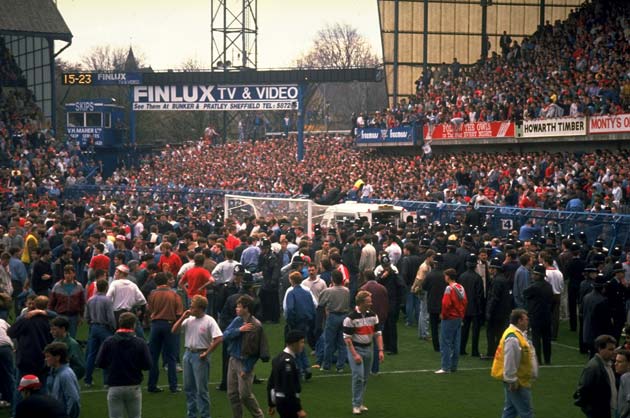'We let Hillsborough fans down' says policeman

Police constable Tom Whiteley expected a party atmosphere when he went on duty at Hillsborough for the 1989 F.A. Cup semi-final.
Instead, by the end of the afternoon, he had carried three dead Liverpool fans to a makeshift morgue set up in the stadium's gym.
They had been crushed to death after being caught in an overcrowded terrace at the Liverpool end of the ground for the match against Nottingham Forest. In all, 96 people died, making it Britain's worst stadium disaster.
In the aftermath of the tragedy, police were criticised in an official report for their failure to control the situation. It led to the removal of fencing at the front of stands and all-seater stadiums, transforming the look and feel of English soccer grounds.
For Whiteley, a 28-year-old inexperienced officer, on duty at Sheffield Wednesday's ground on 15 April, 1989, the disaster sparked a fundamental shift in his outlook on soccer matches - from crowd control to public safety.
"Everybody expected it to be a good day, a day when members of the public, families, spectators could come and enjoy a sporting event and we seriously let people down that day because we didn't keep people safe," Whiteley, now a detective inspector with South Yorkshire police, told Reuters.
Whiteley at first thought it was a pitch invasion, but soon realised "we had a serious disaster on our hands".
He said: "Clearly people were laid out on the ground. People were being dragged out...were being pulled over the fence, but were still being crushed against the fence."
Ambulances could not get on the pitch so police and spectators carried survivors by their arms and legs and on advertising hoardings.
Whiteley said: "If you can imagine there were dozens of people and it was just a priority to move them if they could not be resuscitated from an area where more people were filling the space."
He added: "The last person I carried was somebody who we'd been trying to resuscitate for several minutes before giving up and at that point we put him on a stretcher and moved him away. All the people I carried were clearly dead.
"It's difficult, you make these journeys with these stretchers and you're in full police uniform, you've got your helmet on, you feel like your heart is actually bursting through your chest.
"It was a continual flow of people for quite a period of time. The gym was quite a big area and it was full of bodies when we had finished. It's difficult to envisage what over 90 bodies looks like and a difficult situation to deal with."
He said many police officers and fans helped, "stepping forward and taking responsibility".
"But equally you have got people who were disorientated, police officers who I had known for a considerable amount of time were in tears and disorientated and finding it difficult just to function in that particular situation," he said.
"It's 20 years ago and it's difficult to imagine what it's like in that situation, to experience that, the noise, the people, the disorganisation."
The thought that he did all he could has helped over the years.
The week after the disaster he took up his planned new post at a unit dealing with public disorder at football grounds and sporting events.
"I think about it and what else I could have done," he said.
"I thought about it for weeks and weeks afterwards and if there had been cutting facilities...I could have used that. But I think with the circumstances I faced I really couldn't have done anymore and that really kept me going."
He had not made any conscious decision as to which bodies to pick up and he still cannot remember those he carried.
"As part of the inquiry I was asked to come to police headquarters to view pictures of all the dead people and sets of clothing...and I couldn't recognise anybody because of the trauma of the experience," he said.
"I couldn't actually bring the facial recognition back to mind. Even now."
The events of the day still affect him.
"I like to think that I'm someone who can still perform duties when under pressure, but it affected me in a way that always at the back of my mind is Hillsborough."
Sheffield Wednesday's current manager Brian Laws was a Nottingham Forest player at the time. He was just about to take a throw-in when the game was halted, just minutes into the match.
"I remember doing an interview on the pitch when I first came to the club (Sheffield Wednesday) and I stood on that far side and still looked across from where I took that throw-in. It was still a fresh memory. I have never forgot. Never," he told reporters.
"It was an incredible scene you'd expect on a battlefield, not on a football pitch."
The Nottingham Forest manager Brian Clough refused to send his players back out after he heard there had been a fatality.
"Everybody looks at this as 20 years ago," Laws said.
"It seems hell of a long time, but those who were involved in that period and played a part in it, it doesn't seem 20 years ago it just seems like yesterday.
"You can still recall everything that went on...the build-up and everything just seem fresher in the mind because of the disaster that occurred."
Subscribe to Independent Premium to bookmark this article
Want to bookmark your favourite articles and stories to read or reference later? Start your Independent Premium subscription today.

Join our commenting forum
Join thought-provoking conversations, follow other Independent readers and see their replies